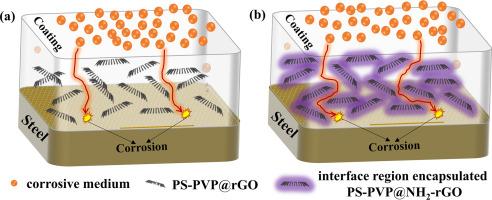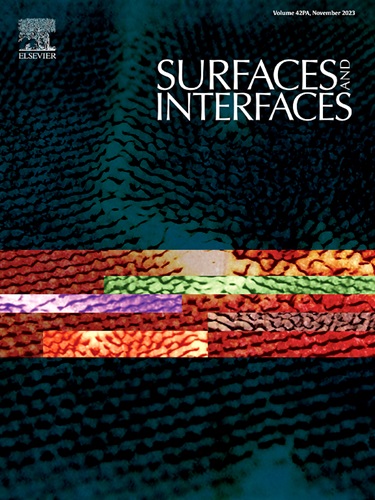Impressive reinforcement on the anti-corrosion ability of the commercial fluorocarbon paint via an amino groups modified graphene
IF 5.7
2区 材料科学
Q2 CHEMISTRY, PHYSICAL
引用次数: 0
Abstract
The interaction with the matrix and the dispersion within the matrix hinder the realization of graphene's potential as an anti-corrosive filler. Herein, a -NH2 modified graphene-based filler (PS-PVP@NH2-rGO) was designed to simultaneously address these issues in the fluorocarbon resin (FEVE) coating. Reinforing FEVE coating with PS-PVP@NH2-rGO, the wear rate and the lowest-frequency impedance modulus after a 7-day immersion were found to be 0.35 times and 177.3 times those of FEVE coating respectively. Ultraviolet-Visible spectra confirmed the excellent dispersibility of PS-PVP@NH2-rGO. The designed differential scanning calorimeter experiment demonstrated the close interaction between PS-PVP@NH2-rGO and the FEVE matrix. Due to this close interaction, PS-PVP@NH2-rGO exhibited a high degree of dispersion within the FEVE matrix rather than self-aggregation, then concentrated the stress outside, absorbed energy produced during the friction process, and enhanced the coating's wear resistance. A complicated “labyrinth” was also created by the fillers. With chemical interactions, the fillers and the surrounding FEVE matrix formed an integrated whole, making the “obstacles” created by the fillers more significant. Consequently, the strong barrier effect resulted in superior anti-corrosion performances of PS-PVP@NH2-rGO/FEVE coating. Introducing -NH2 groups in was proven to effectively complete the coating, improve coating's quality and barrier effect, and finally prevent corrosive media. This study aims to provide design ideas and theoretical supports for high-performance heavy-duty anti-corrosive coatings.

通过氨基修饰石墨烯显著增强商用氟碳漆的防腐能力
与基体的相互作用以及在基体中的分散阻碍了石墨烯作为抗腐蚀填料潜力的发挥。在此,我们设计了一种 -NH2 改性石墨烯基填料(PS-PVP@NH2-rGO),以同时解决氟碳树脂(FEVE)涂层中的这些问题。用 PS-PVP@NH2-rGO 加固 FEVE 涂层,发现浸泡 7 天后的磨损率和最低频率阻抗模量分别是 FEVE 涂层的 0.35 倍和 177.3 倍。紫外-可见光谱证实了 PS-PVP@NH2-rGO 具有良好的分散性。设计的差示扫描量热仪实验证明了 PS-PVP@NH2-rGO 与 FEVE 基质之间的密切相互作用。由于这种密切的相互作用,PS-PVP@NH2-rGO 在 FEVE 基体中表现出高度分散,而不是自聚,从而集中了外部应力,吸收了摩擦过程中产生的能量,增强了涂层的耐磨性。填料还形成了一个复杂的 "迷宫"。通过化学作用,填料和周围的 FEVE 基质形成了一个整体,使填料造成的 "障碍 "更加明显。因此,强大的阻隔效应使 PS-PVP@NH2-rGO/FEVE 涂层具有卓越的防腐蚀性能。事实证明,引入 -NH2 基团可以有效地完善涂层,提高涂层的质量和阻隔效果,并最终防止腐蚀性介质的侵蚀。本研究旨在为高性能重防腐涂料提供设计思路和理论支持。
本文章由计算机程序翻译,如有差异,请以英文原文为准。
求助全文
约1分钟内获得全文
求助全文
来源期刊

Surfaces and Interfaces
Chemistry-General Chemistry
CiteScore
8.50
自引率
6.50%
发文量
753
审稿时长
35 days
期刊介绍:
The aim of the journal is to provide a respectful outlet for ''sound science'' papers in all research areas on surfaces and interfaces. We define sound science papers as papers that describe new and well-executed research, but that do not necessarily provide brand new insights or are merely a description of research results.
Surfaces and Interfaces publishes research papers in all fields of surface science which may not always find the right home on first submission to our Elsevier sister journals (Applied Surface, Surface and Coatings Technology, Thin Solid Films)
 求助内容:
求助内容: 应助结果提醒方式:
应助结果提醒方式:


